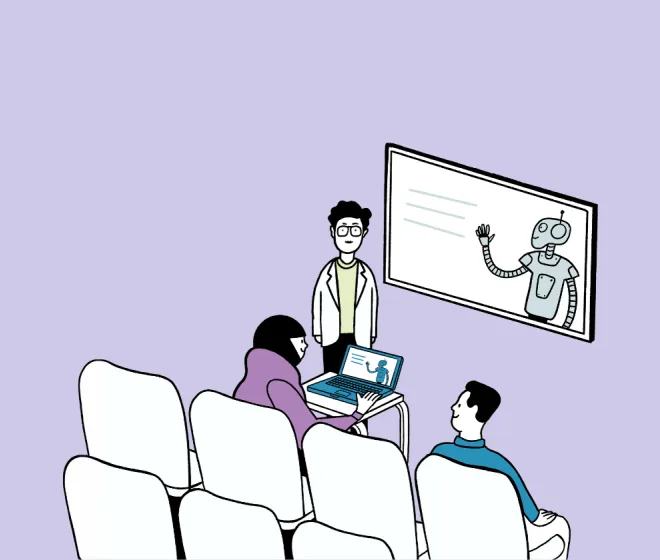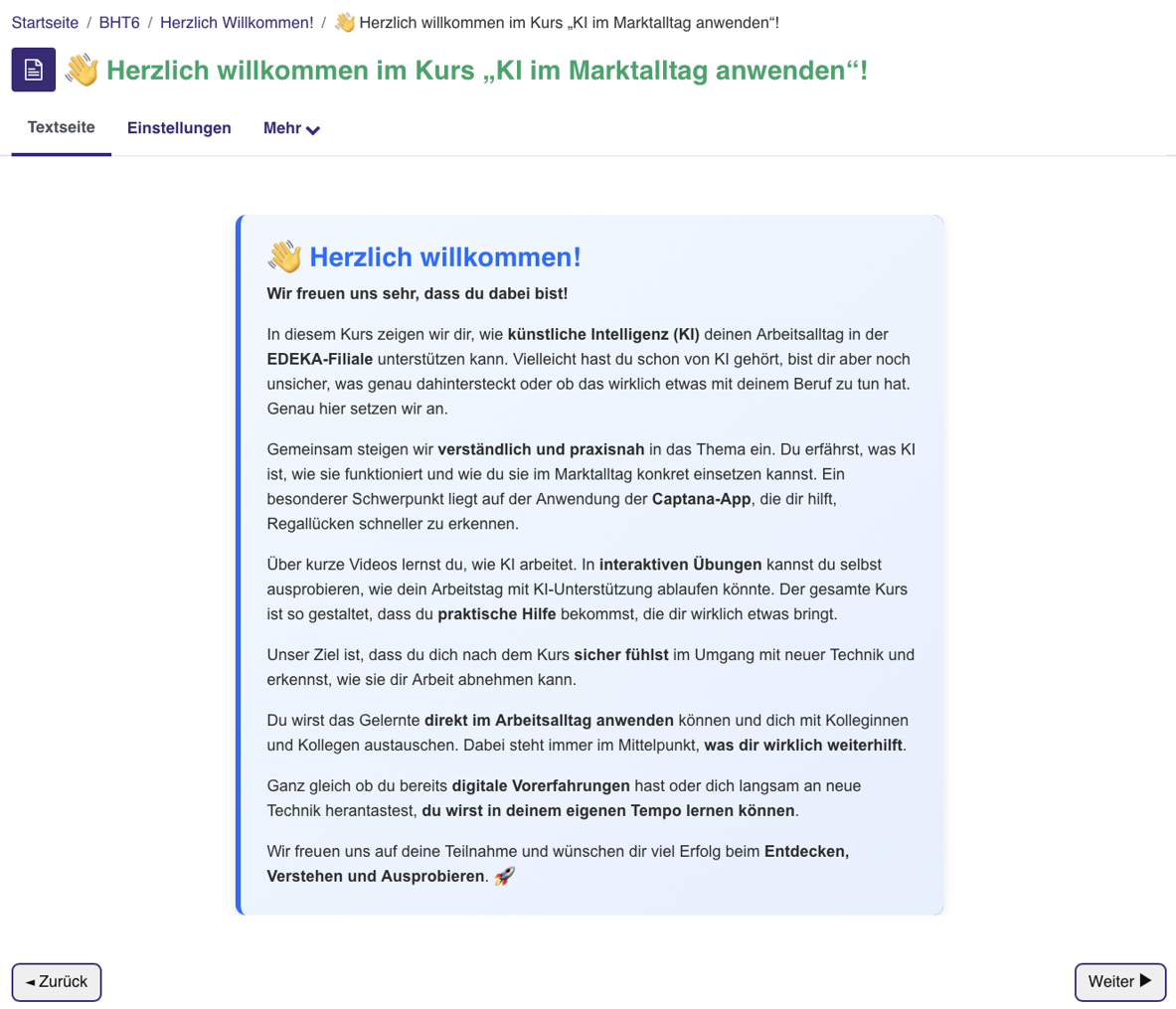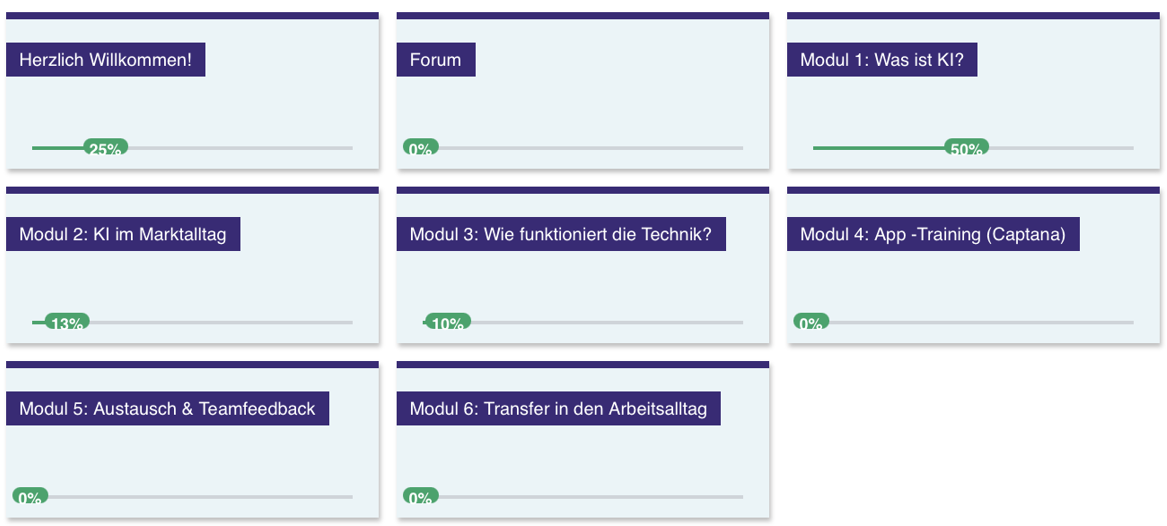AI in the Supermarket: Prototype for an Online Course






Artificial intelligence can already make everyday work in the food retail sector easier. We – five students from the Berliner Hochschule für Technik – have developed a suitable online course in cooperation with the AI Campus. Employees in retail learn how to use AI-based systems in a stress-free, competent and enjoyable way. In this article, we show how a real-world problem can be turned into a learning opportunity that makes technology accessible.
From BHT to AI Campus – our journey
When we started the Learning Design module in the summer semester of 2025, we had already heard that the AI Campus offers digital learning opportunities relating to artificial intelligence, but we still had no concrete idea how to develop a course ourselves. Our seminar, led by Prof. Dr Ilona Buchem in the Digital Economy degree course, then offered us exactly this opportunity: We were to design a practice-oriented learning opportunity that addresses real challenges and can be implemented via the AI Campus. For us, this was an exciting opportunity, because we were not only able to draw up a concept on paper, but also to see directly what it would look like on a real learning platform. The AI Campus was much more than a technical platform for us – it served as a source of inspiration, an example (for instance, the course “AI for Everyone”) and a playground for our own ideas.
Our use case – an example from food retail
It all began with a very everyday observation: during peak times, it becomes extremely difficult for store employees to keep an eye on everything at once. A friend from our team spoke about her daily work in a supermarket branch: between the till, customers, stockroom and coordination, there’s hardly time to constantly patrol every aisle. This means shelves remain empty, customers become frustrated, and revenue is lost. Automated shelf monitoring with AI can help here. In our course, we used an existing technology as an example to show how AI systems basically work and the benefits they can bring. Especially since this technology is already being used in pilot projects, we were able to portray a realistic scenario that will be familiar to many working in food retail.
Didactic approach: Empathy and motivation
But we didn’t just want to explain the technology; above all, we wanted to put people at the centre. That’s why, at the start, we created an Empathy Map – a user-centred design tool that helps us take on the perspective of the target group. Our fictional persona, “Sandra Becker” – 42 years old, deputy store manager – represents many employees: dedicated, open to new things, but also under pressure and sometimes uncertain with complex technology. This Empathy Map showed us which concerns, wishes and learning barriers we needed to take seriously: clear language, illustrative examples, short videos, simulations and opportunities for social exchange instead of lengthy technical texts. This way, we were able to derive our content directly from the needs of the target group.
To ensure that motivation doesn’t come down to luck, we based our course design on John Keller’s ARCS model. This model describes four building blocks for sustainable motivation: Attention (arousing curiosity), Relevance (demonstrating relevance), Confidence (building self-confidence) and Satisfaction (making success visible). This structure helped us plan each step carefully – from the first curiosity-piquing video to the final badge that rewards learning progress.
Our course for the AI Campus – how it works
The course is modular and was implemented via the Moodle environment of the AI Campus. Six modules take learners from the basics of artificial intelligence through practical application to reflection in the real workplace. We guide the learners step by step.
Some highlights and personal insights:
- Low-threshold starting point: We begin with videos and interactive exercises that playfully explain what AI is and where we already encounter it today.
- Practice-based scenario: “A day in the store with and without AI” gives an experiential demonstration of how workflows can change – a real before-and-after experience.
- Simulations and checklists: Before things get serious, participants can practise in a safe environment and get feedback.
- Forums and mini-workshops: Nobody learns alone – exchanging with colleagues breaks down barriers and creates new ideas.
- Gamification elements: Badges, progress displays and small achievements make learning successes visible and motivate people to keep going.
We wanted to design a course that doesn’t feel like “school”, but rather like a helpful tool that people enjoy using. For us as a team, it was exciting to see how an idea became a real learning opportunity. The course is currently still a prototype and is based on a specific company example. In future, it could be made publicly accessible via the AI Campus as a so-called white-label course – meaning without reference to a particular company.
Impact and outlook
The course links technological innovation with human acceptance. It shows that training about AI doesn’t have to be dry or abstract, but can be practical, empathetic and motivating. Although our example comes from food retail, the concept can be transferred to many sectors – anywhere routine tasks can be supported by AI. We believe that it is precisely these kinds of learning opportunities that will make digital transformation more human.
For us personally, this project was also a learning journey. Not only did we apply didactic models, but we also experienced how important teamwork, openness and feedback are when developing something new. The AI Campus served as a space for learning and experimentation, where we were able to put our own ideas into practice.







